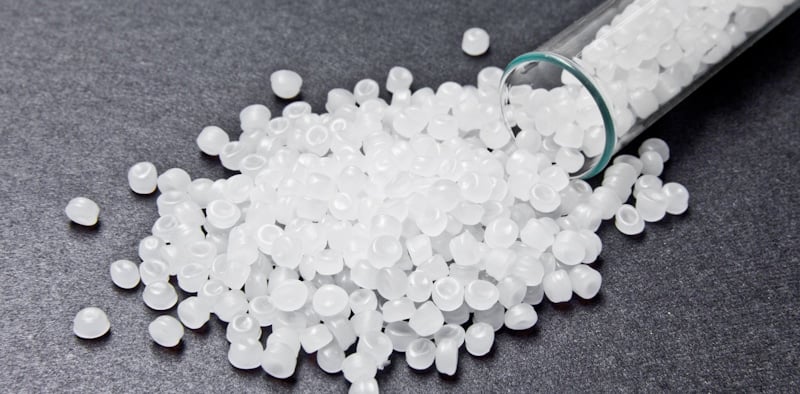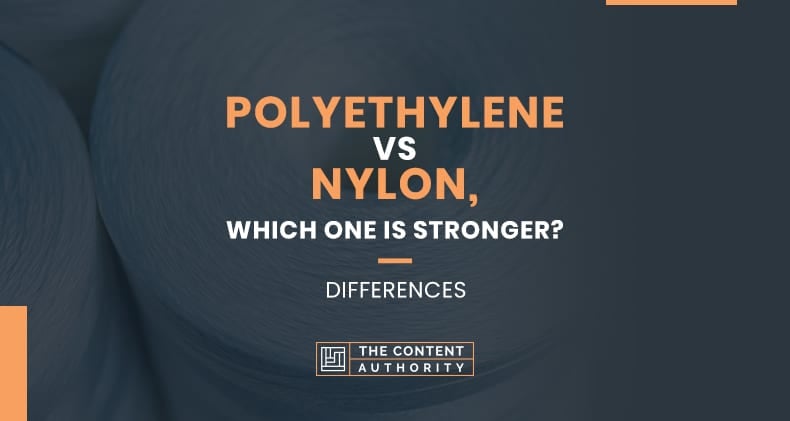Both are common materials used in our daily lives. For nylon, many uses include fabric, book packs, toothbrushes, carpets, clothing such as the known “nylons,” in women’s hosiery, and many more. You can find Polyethylene in toys, home appliances, plastic bottles, caps, etc. But have you wondered which material is stronger?
If we are talking about strength, when comparing nylon and polyethylene, Nylon is stronger. Nylon has a tensile strength of 12,400 psi (pounds per square inch). Polyethylene, however, even in its three most common types – low, high, and ultra-high molecular density – ranges from 1,800 to 3,100 psi.
Polyethylene Versus Nylon: Definitions

What Is Polyethylene?
Polyethylene (PE) is a thermoplastic that is durable and with a variable crystalline structure. It is one of the most commonly produced plastics in the world. Every year, it has a production of millions of tons worldwide -. PE is also one of the most used plastics. Its uses include different applications from laminates, plastic parts, tubes, films, and much more. Other industries include electrical, automotive, packaging, etc.).
From the result of the polymerization of ethylene (or ethene) monomers, we obtain PE.
What Is Nylon?
Nylon (or Polyamides) is the major engineering and high-performance thermoplastics class because of its good balance of properties. It is formed by condensing monomers and copolymers for different units. Polyamides contain repeating amide linkages.
- The monomers may be aliphatic, semi-aromatic, or aromatic (aramids)
- They may be amorphous, semi-crystalline, and of greater or lesser crystallinity
Polyethylene Versus Nylon: Properties
Polyethylene: Properties
PE properties can be classified into:
- Thermal
- Electrical
- Chemical
- Mechanical
- Optical
Thermal Properties |
Compared to other types of thermoplastics, the PE commercial applicability is limited by its low melting point.
The melting point is usually between 248 and 266 °F, for common commercial grades of medium and high-density PE. |
Electrical Properties |
PE is a fine electrical insulator. It provides good electrical treeing resistance. However, it becomes easily charged with electricity and static (adding antistatic agents, carbon black, or graphite reduces it). |
Chemical Properties |
PE consists of nonpolar, saturated, high-molecular-weight hydrocarbons. Therefore, if you want to talk about chemical behavior, it is similar to paraffin.
They tend to crystallize, mainly due to their symmetric molecular structure, so PE is moderately crystalline overall. Increased density and chemical and mechanical stability are due to higher crystallinity. |
Mechanical Properties |
PE is of low strength, hardness, and rigidity but has high flexibility and impact strength, also low friction.
Under constant force, it shows strong creep. Adding short fibers can reduce creep. It also has a waxy feeling when touched. |
Optical Properties |
PE can vary between opaque, translucent (milky-opaque), and transparent (almost clear) depending on film thickness and thermal history.
Crystallites reduce transparency when they are larger than the visible light wavelength. |
Nylon: Properties
Nylon properties include these main characteristics:
- It dries quickly
- It does not absorb water
- It is resilient
- It is resistant to damages caused by oil and chemicals
- It is very strong
- It is elastic
- It is lustrous
Tensile Strength: Nylon´s Most Important Feature
Regarding plastics’ mechanical properties, for materials used in structural applications, one of the most important and widely measured properties is resisting breaking under tensile stress.
Tensile strength is also known as ultimate tensile strength. It refers to the amount of stress a plastic can resist without breaking when it is pulled or stretched, especially for materials that will have to be under tension or stretched for some reason.
Nylon has a tensile strength equal to 12,400 psi. It is used in many different ways, such as rope, to reinforce rubber material (like car tires) or clothing, and even to substitute low-strength metals.
In addition to its high strength and excellent tensile properties, nylon has a relatively high melting point (450ºF) and exhibits excellent abrasion resistance. It has high chemical resistance and is not damaged by oils, solvents, or alcohol.
Polyethylene Versus Nylon: Strengths And Weaknesses
Polyethylene
Advantages
- PE is durable and resistant to water. Therefore, when exposed to the elements compared to other polymers, it lasts longer.
- PE has many useful properties that make it ideal for a variety of applications. Despite having low strength and hardness, it has good impact strength, and it is very malleable. So, instead of breaking, it will stretch.
- PE can be either almost transparent or opaque, and it will depend on how thick the PE is. Because of how clear low-density PE is, it makes it appropriate for packaging.
- PE is also a good electric insulator. It can offer resistance to electric treeing; however, it can become electrostatically charged. If antistatic agents are added, it will prevent this from happening.
Disadvantages
- PE is susceptible to cracking due to stress.
- PE is mainly extracted from natural gas or petroleum. There is a limited amount of these components.
- PE has a low resistance to UV and heat.
- The creation of PE takes huge amounts of energy, which leads to high carbon dioxide emissions. Unfortunately, this greenhouse gas contributes to climate change and global warming.
- PE has lower stiffness compared to polypropylene.
- PE makes it impossible to perform high-frequency welding and joining.
- Like other plastics, the polymer takes a long time to disintegrate, meaning that it ends up in disposable areas for decades.
- Another method for PE disposal is by incineration. It can also result in harmful gas emissions.
- PE has high shrinkage due to mold.
Nylon
Advantages
- Nylon is the toughest material compared to PE.
- Nylon is great for underground applications, such as water wells.
- Nylon is very durable, which makes it very useful for watering systems, livestock, and barns.
- Nylon can take the largest abuse of twisting and stretching.
Disadvantages
- Nylon is not ideal to be exposed to sunlight.
- UV rays can cause nylon fittings to become greatly fragile and fail.
- Many chemicals are not good to be used with nylon fittings.
Main Differences And Characteristics
Between PE and nylon, the main difference is that PE is a polymer. At the same time, nylon is part of the family of synthetic polymers. Originally, nylon was developed as textile fibers.
| Material | Other Names | Type Of Fiber | Main Characteristic |
| Nylon | Polyamide | It is a synthetic fiber widely used when maximum strength with minimum diameter is required. | Its main characteristics are a high tensile strength (breakage). It holds more kg/m than any other fiber and has high resistance to solar incidence and abrasion by friction.
On the other hand, it has a higher water absorption level than other materials. Its resistance weakens in environments with chlorine. From the three fibers compared, it is the most resistant to sunlight and climatic changes; it is heavier than water, so it sinks. Its appearance is textile, and it is ideal for exteriors. |
| Polyethylene | PE | It is a synthetic fiber with a plastic feel. | Its main characteristics are:
On the contrary, its tensile strength is medium, and it was not designed for load-bearing applications. It is plastic in appearance, and of the three fibers compared, it is the most difficult to handle; it weighs very little (it floats). It is very resistant to abrasion, but its resistance to the sun is average. |
Conclusion
Nylon is considered a high tensile strength plastic. It also has high insulation and great resistance to corrosion. So, if your next project requires material strength, nylon is your best option.
Shawn Manaher is the founder and CEO of The Content Authority. He’s one part content manager, one part writing ninja organizer, and two parts leader of top content creators. You don’t even want to know what he calls pancakes.


